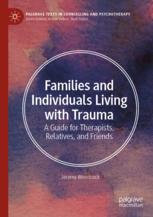If someone you love, a family member or friend has suffered a serious trauma, this is a book for you. It is a book for the general reader and it is a book for therapists. It sets out to explain trauma, describes a way through it, and how you can support and help. If you are a therapist working with individuals and families it sets out to be an essential text. It reveals in detail what works therapeutically and how to navigate a way through. Each chapter takes a theme such as beginnings, or body brain and trauma, or when disaster strikes and with stories of the work and case material describes what can be learned in order to be a supportive family member and friend, or an effective therapist. There is naturally an inevitable tension between being either a family member, friend, or therapist and how much one can do to help. This is not a book about encouraging family members and friends to be therapists, but what it attempts is to describe clearly what can be supportive, and then charts in more depth the nature of therapeutic work that will help. By describing the deeper therapeutic work it endeavors to create an understanding of what work with trauma entails, and to deepen family members and friends capacity to live alongside someone else’s trauma in ways that
چکیده فارسی
اگر کسی که دوستش دارید، یکی از اعضای خانواده یا دوستتان آسیب جدی دیده است، این کتاب برای شماست. کتابی است برای عموم خوانندگان و کتابی برای درمانگران. هدف از آن توضیح تروما است، راهی برای عبور از آن و نحوه حمایت و کمک به شما توضیح می دهد. اگر شما یک درمانگر هستید که با افراد و خانوادهها کار میکند، متنی ضروری است. این با جزئیات نشان می دهد که چه چیزی از نظر درمانی کار می کند و چگونه می توان راهی را طی کرد. هر فصل موضوعی مانند شروع، یا مغز و ضربه جسمی، یا زمانی که فاجعه رخ میدهد و با داستانهایی از کار و مطالب موردی، توصیف میکند که چه چیزی را میتوان آموخت تا عضوی از خانواده و دوست یا یک درمانگر مؤثر باشد. به طور طبیعی تنش اجتناب ناپذیری بین یکی از اعضای خانواده، دوست یا درمانگر بودن و میزان کمکی که فرد می تواند انجام دهد وجود دارد. این کتابی در مورد تشویق اعضای خانواده و دوستان به درمانگر نیست، اما آنچه در آن تلاش میشود این است که به وضوح آنچه میتواند حمایتکننده باشد، و سپس نمودارهای عمیقتری از ماهیت کار درمانی که کمک میکند، ترسیم کند. با توصیف کار درمانی عمیقتر، تلاش میشود تا درک درستی از آنچه که کار با تروما به دنبال دارد ایجاد کند، و ظرفیت اعضای خانواده و دوستان را برای زندگی در کنار آسیبهای دیگران به روشهایی تقویت کند که
ادامه ...
بستن ...
The word trauma is used liberally and uncritically throughout the book although in my professional work I take a far more critical stance in relation to its use, and this raises very important issues to do with how we survive the bad things that happen to us. Extreme events happen frequently but not everyone who endures such an event will suffer psychological trauma. The reasons for this are complex and can be under- stood in terms of hardiness and resilience. This can involve many factors from how we process emotional overload neurologically and physically, through to the nature of the communities in which we live, and most importantly the social meanings that are ascribed to extreme events. This doesn’t mean that trauma only appears when it is labeled as such. Trauma can live underground for years, consider the Me Too movement; or gener- ations, consider Black Lives Matter, or centuries, consider the pernicious effects of slavery. My preference is to use extreme events to label the event itself, and trauma as the psychological aftermath that may follow, but is not inevitable. In the territory that lies between there are a plethora of contending forces: how much light and voice that are brought to events to validate experience; how much support is forthcoming; the extent to which people are empowered to cope with events, and in the extreme moment how overwhelmed we are in ways that compel us to respond in ways that undo us. To this can be added our individual capacity for hardi- ness or our vulnerability to overwhelm, and these are not static qualities but are deeply influenced by social factors, the quality of our relation- ships and quite critically, our fluctuating capacity for reflection. However, in the book trauma is used liberally for those who self-identify as being traumatized, and for families, friends, and therapists who would offer this description. In brief, this means people who have survived extreme circumstances that would ordinarily overwhelm any of us, and who have
ادامه ...
بستن ...










